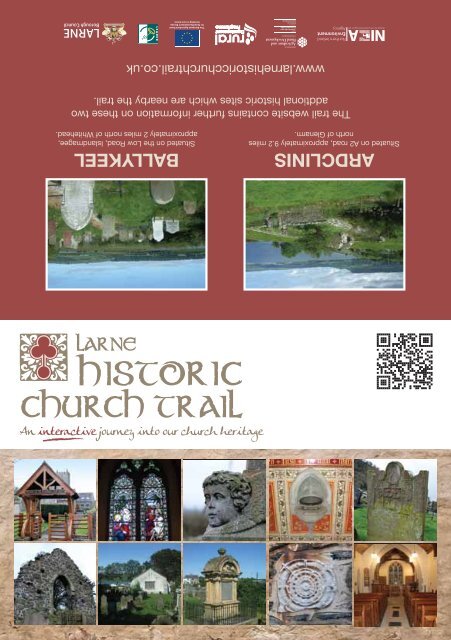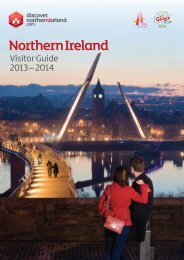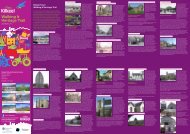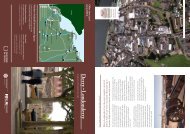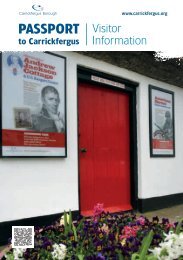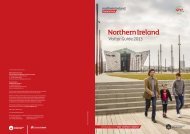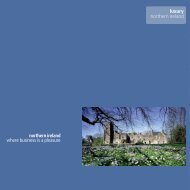Larne Historic Church Trail - Causeway Coast and Glens
Larne Historic Church Trail - Causeway Coast and Glens
Larne Historic Church Trail - Causeway Coast and Glens
You also want an ePaper? Increase the reach of your titles
YUMPU automatically turns print PDFs into web optimized ePapers that Google loves.
ARDCLINIS BALLYKEEL<br />
Situated on A2 road, approximately 9.2 miles<br />
north of Glenarm.<br />
Situated on the Low Road, Isl<strong>and</strong>magee,<br />
approximately 2 miles north of Whitehead.<br />
The trail website contains further information on these two<br />
addtional historic sites which are nearby the trail.<br />
www.larnehistoricchurchtrail.co.uk
INTRODUCTION<br />
Welcome<br />
Welcome to the <strong>Larne</strong> <strong>Historic</strong> <strong>Church</strong> <strong>Trail</strong>. This<br />
easy-to-follow trail will guide you around some of<br />
the oldest churches <strong>and</strong> graveyards in County<br />
Antrim. Each site tells a story, built into the stone<br />
work of its walls, <strong>and</strong> inscribed on the memorials<br />
in the churchyard.<br />
This brochure will give you a flavour of<br />
<strong>Larne</strong>’s church heritage. It will let you<br />
glimpse what you can discover within<br />
only a short distance of our town. But<br />
the only true way to experience all<br />
that these churches <strong>and</strong> graveyards<br />
can reveal, is to visit <strong>and</strong> explore them<br />
at your leisure.<br />
Plan your route<br />
You may decide to stop off <strong>and</strong> do<br />
some exploration at all the points, in<br />
which case the tour may take most of<br />
a day – just depending on how long<br />
you spend at each location. Or you<br />
might decide to plan your own route<br />
around the sites that interest you<br />
most, by following all the points<br />
highlighted on the tour map.<br />
You’ll see some beautiful places, <strong>and</strong><br />
you’ll have an opportunity to explore<br />
an aspect of our history that’s maybe<br />
less well known. And like all the best<br />
things in life, some of our destinations<br />
require a little time <strong>and</strong> effort to reach.<br />
So be prepared for the weather - <strong>and</strong><br />
wear a good pair of comfortable<br />
shoes!<br />
QR codes <strong>and</strong> website<br />
More detailed information can be<br />
found on the trail website:<br />
www.larnehistoricchurctrail.co.uk<br />
or simply scan in the QR codes by<br />
downloading a free app for your smart<br />
phone/device.
ST JOHN’S<br />
Broughshane<br />
Kells<br />
The<br />
Sheddings<br />
A36<br />
Ballyclare<br />
6<br />
Cairncastle<br />
Kilwaughter<br />
A8<br />
Glenarm<br />
<strong>Larne</strong> Rd<br />
5<br />
Belfast Rd<br />
Ballygally<br />
Glynn<br />
<strong>Larne</strong><br />
4<br />
3<br />
Ballycarry<br />
2<br />
A2<br />
1<br />
Isl<strong>and</strong>magee<br />
Whitehead<br />
A2<br />
Ballycarry<br />
B90<br />
<strong>Larne</strong> Rd<br />
B90<br />
Low Rd<br />
Access details: Access to St. John’s graveyard<br />
is available throughout the hours of daylight.<br />
Middle Rd<br />
Isl<strong>and</strong>magee<br />
1<br />
2<br />
3<br />
4<br />
5<br />
6<br />
1. St. John's<br />
Isl<strong>and</strong>magee<br />
2. Templecorran<br />
Ballycarry<br />
3. Glynn Old <strong>Church</strong><br />
Glynn<br />
4. St Cedma’s<br />
Inver, <strong>Larne</strong><br />
5. St. Patrick’s<br />
Cairncastle<br />
6. Glenarm Friary<br />
Glenarm<br />
St John’s <strong>Church</strong>, Isl<strong>and</strong>magee<br />
St John’s <strong>Church</strong>, Isl<strong>and</strong>magee, is one of the oldest places of<br />
worship in Irel<strong>and</strong> still in regular use.<br />
Early history<br />
St John’s was probably built in the late sixteenth century,<br />
although renovations in the 1820s uncovered the foundations<br />
of an older <strong>and</strong> larger building, which suggests it may st<strong>and</strong> on<br />
the site of an even older church.<br />
The church since the early<br />
nineteenth century<br />
Prior to 1828, the church measured<br />
27 metres by 8.5 metres, with an aisle<br />
or transept attached to the west end<br />
of the north side. In that year 8.5<br />
metres of the main body of the church<br />
were removed <strong>and</strong> a new roof was<br />
installed. There have been relatively<br />
few changes to the church since<br />
1840.<br />
The churchyard<br />
The churchyard has a large number of<br />
headstones, most of which are in<br />
good condition. The earliest date of<br />
death on any gravestone is 1752, so it<br />
is possible that the practice of burying<br />
in this churchyard did not start until<br />
the middle of the eighteenth century.<br />
Maritime associations<br />
All of the burial grounds in Isl<strong>and</strong>magee<br />
contain a very high proportion of<br />
gravestones with maritime associations.<br />
James Campbell <strong>and</strong> William<br />
Johnston were both washed<br />
overboard, the former off the Cape of<br />
Good Hope in 1867, <strong>and</strong> the latter<br />
from the schooner G. F. Williams in<br />
1876.<br />
Clergy memorials<br />
By the end of the nineteenth century<br />
there were four churches in Isl<strong>and</strong>magee.<br />
Several gravestones<br />
commemorate clergymen who<br />
ministered in the parish or members<br />
of their families.
TEMPLECORRAN<br />
Broughshane<br />
Kells<br />
The<br />
Sheddings<br />
A36<br />
Ballyclare<br />
6<br />
Cairncastle<br />
Kilwaughter<br />
A8<br />
Glenarm<br />
<strong>Larne</strong> Rd<br />
5<br />
Belfast Rd<br />
Ballygally<br />
Glynn<br />
<strong>Larne</strong><br />
4<br />
3<br />
Ballycarry<br />
A2<br />
1<br />
Isl<strong>and</strong>magee<br />
Whitehead<br />
Templecorran Graveyard<br />
The graveyard of Templecorran st<strong>and</strong>s on the site<br />
of an Early Christian monastery. By the medieval<br />
period, a parish church stood here, possibly the<br />
‘<strong>Church</strong> of Laslaynan’ as recorded in the papal<br />
taxation of 1306.<br />
2<br />
St<br />
Main<br />
Rd<br />
dgend Bri<br />
Ballycarry<br />
Main Bentra Rd<br />
Isl<strong>and</strong> Rd B90<br />
A2<br />
<strong>Larne</strong> Rd A2<br />
Access details: Access to the ruins<br />
of Templecorran is available<br />
throughout the hours of daylight.<br />
1<br />
2<br />
3<br />
4<br />
5<br />
6<br />
1. St. John's<br />
Isl<strong>and</strong>magee<br />
2. Templecorran<br />
Ballycarry<br />
3. Glynn Old <strong>Church</strong><br />
Glynn<br />
4. St Cedma’s<br />
Inver, <strong>Larne</strong><br />
5. St. Patrick’s<br />
Cairncastle<br />
6. Glenarm Friary<br />
Glenarm<br />
The arrival of the Scots<br />
In the early seventeenth century the<br />
Ballycarry area was a favoured<br />
destination for Scottish settlers<br />
l<strong>and</strong>ing in east Antrim. In 1613 the<br />
Rev. Edward Brice was appointed as<br />
the first Presbyterian minister of<br />
Templecorran.<br />
The church ruins<br />
The roofless ruins of the church in<br />
which Brice once preached st<strong>and</strong><br />
reasonably intact. Unusually, it is built<br />
on the plan of a Greek cross, with<br />
each arm of the cross of equal length.<br />
Twelve musket loops in its walls<br />
suggest the church was more than<br />
just a place of worship – it was also<br />
designed to provide refuge in case of<br />
attack.<br />
Later history of the church<br />
Templecorran church gradually fell<br />
into a state of disrepair <strong>and</strong> by 1679 it<br />
was in ruins. For a brief period in the<br />
1690s, it was one of the parishes for<br />
which the celebrated novelist,<br />
Jonathan Swift, was responsible. In<br />
1847, a new Anglican church<br />
dedicated to St John was built beside<br />
the old churchyard.<br />
The churchyard<br />
The memorials in the burial ground<br />
date back over a thous<strong>and</strong> years. The<br />
oldest memorial is a stone that almost<br />
certainly dates from the Early<br />
Christian period.
GLYNN OLD CHURCH<br />
Broughshane<br />
Kells<br />
The<br />
Sheddings<br />
A36<br />
Ballyclare<br />
6<br />
Cairncastle<br />
Kilwaughter<br />
A8<br />
Glenarm<br />
<strong>Larne</strong> Rd<br />
5<br />
Belfast Rd<br />
Ballygally<br />
Glynn<br />
<strong>Larne</strong><br />
4<br />
3<br />
Ballycarry<br />
2<br />
A2<br />
1<br />
Isl<strong>and</strong>magee<br />
Whitehead<br />
A2<br />
Glenburn Rd<br />
Rectory Rd<br />
Glynn<br />
Shore Rd A2<br />
Access details: Access to the ruins<br />
of Glynn Old <strong>Church</strong> is available<br />
throughout the hours of daylight.<br />
1<br />
2<br />
3<br />
4<br />
5<br />
6<br />
1. St. John's<br />
Isl<strong>and</strong>magee<br />
2. Templecorran<br />
Ballycarry<br />
3. Glynn Old <strong>Church</strong><br />
Glynn<br />
4. St Cedma’s<br />
Inver, <strong>Larne</strong><br />
5. St. Patrick’s<br />
Cairncastle<br />
6. Glenarm Friary<br />
Glenarm<br />
Glynn Old <strong>Church</strong> <strong>and</strong> <strong>Church</strong>yard<br />
Beautifully situated in wooded surroundings along<br />
the east Antrim coast, with views to the east looking<br />
out across <strong>Larne</strong> Lough, the site of old church<br />
at Glynn has fascinated visitors for centuries.<br />
The old church<br />
The ruins of the old church are<br />
substantial <strong>and</strong> consist of a structurally<br />
divided nave <strong>and</strong> chancel. This is<br />
unusual, as most medieval parish<br />
churches in Ulster had no such<br />
division. The chancel is also long in<br />
comparison to the nave. Differences<br />
in masonry suggest the chancel may<br />
have been added at a later date –<br />
possibly the fourteenth century.<br />
The new church<br />
The parish of Glynn was separated<br />
from <strong>Larne</strong> <strong>and</strong> Inver in 1838 <strong>and</strong> two<br />
years later, a new church was built on<br />
a site at the west end of the old<br />
churchyard. A special service to mark<br />
its opening was held on Wednesday,<br />
9 December 1840.<br />
The churchyard<br />
The ruined church st<strong>and</strong>s in the<br />
north-east section of a rectangular<br />
graveyard which was extended to the<br />
south in 1912. The earliest inscriptions<br />
date from the early eighteenth<br />
century. Among these are the memorials<br />
to John MccClell<strong>and</strong> who died in<br />
1714 aged 82 <strong>and</strong> Margaret Fowlerton,<br />
who died in 1716 [1717]. In a<br />
small walled enclosure, abutting the<br />
exterior of the east gable, is a broken<br />
box tomb in memory of the McCleverty<br />
family, one of the most<br />
distinguished families in the parish.
Glynn Rd<br />
ST. CEDMA’S<br />
Broughshane<br />
Kells<br />
The<br />
Sheddings<br />
A36<br />
Ballyclare<br />
6<br />
Cairncastle<br />
Kilwaughter<br />
A8<br />
Glenarm<br />
<strong>Larne</strong> Rd<br />
5<br />
Belfast Rd<br />
Ballygally<br />
Glynn<br />
<strong>Larne</strong><br />
4<br />
3<br />
Ballycarry<br />
2<br />
A2<br />
1<br />
Isl<strong>and</strong>magee<br />
Whitehead<br />
Access details: Access to St Cedma’s Parish <strong>Church</strong><br />
<strong>Larne</strong>, is by calling at the Parish Office (next to the church),<br />
Monday to Fridays 9.30am to 12.30pm.<br />
<strong>Larne</strong><br />
Inver Rd<br />
Pound St<br />
A8<br />
<strong>Church</strong> Way<br />
High St<br />
A8<br />
Station Rd<br />
1<br />
1. St. John's<br />
Isl<strong>and</strong>magee<br />
2<br />
3<br />
4<br />
5<br />
6<br />
2. Templecorran<br />
Ballycarry<br />
3. Glynn Old <strong>Church</strong><br />
Glynn<br />
4. St Cedma’s<br />
Inver, <strong>Larne</strong><br />
5. St. Patrick’s<br />
Cairncastle<br />
6. Glenarm Friary<br />
Glenarm<br />
An ancient place of worship<br />
St Cedma’s <strong>Church</strong> st<strong>and</strong>s on an ancient ecclesiastical site,<br />
possibly dating back 1,500 years. A monastery once stood at<br />
Inver <strong>and</strong> the site of St Cedma’s marks the location of its<br />
chapel. The <strong>Church</strong> of St Cedma of ‘Ynver’ is listed in the<br />
papal taxation of 1306. But in the late medieval period a<br />
Franciscan Third Order Regular community was established at<br />
Inver. The Franciscans probably took over the site of St<br />
Cedma’s <strong>and</strong> reused the church building.<br />
The church building<br />
It is thought that St Cedma’s church<br />
was built around 1350 <strong>and</strong> it has been<br />
extensively remodelled over the<br />
years. A narrow window in its north<br />
wall is known as the ‘Leper’s Squint’ -<br />
lepers were kept out of the church<br />
<strong>and</strong> would listen to the service from<br />
this spot outside.<br />
The church interior<br />
Early nineteenth century renovations<br />
robbed the interior of its Jacobean<br />
architecture <strong>and</strong> high oak-canopied<br />
pews. That said, the interior of the<br />
church today is one of the finest in<br />
County Antrim, with an impressive<br />
number of high quality stained glass<br />
windows. Two exceptional stained<br />
glass windows in the south wall of the<br />
nave are by Miss Wilhelmina Geddes.<br />
The churchyard<br />
For centuries this churchyard was the<br />
principal burial place in <strong>Larne</strong>, used<br />
by all denominations, so it is full of<br />
interesting memorials. One of its most<br />
interesting features is the lych-gate,<br />
which provided a dry place for a coffin<br />
to rest on the way to the church.<br />
Stories from the stones<br />
There is a fair range of gravestones<br />
in this churchyard, each of which<br />
communicates something of both<br />
those commemorated <strong>and</strong> the<br />
person or persons who erected it.<br />
The earliest gravestone, based on<br />
the date of decease, commemorates<br />
James Murdoch who died on 23 Feb.<br />
1677.
ST. PATRICK’S<br />
6<br />
Glenarm<br />
Access details: The church is usually open on Sundays from 11.30am –<br />
12.30pm for Sunday worship, at other times please contact Jenny on<br />
28583061 or Lindsay on 28583081/07540888384 who can open the<br />
church by arrangement.<br />
1<br />
1. St. John's<br />
Isl<strong>and</strong>magee<br />
Broughshane<br />
Kells<br />
The<br />
Sheddings<br />
Ballyclare<br />
Cairncastle<br />
Kilwaughter<br />
A36<br />
A8<br />
<strong>Larne</strong> Rd<br />
5<br />
Belfast Rd<br />
Ballygally<br />
Glynn<br />
<strong>Larne</strong><br />
4<br />
3<br />
Ballycarry<br />
2<br />
A2<br />
1<br />
Cairncastle<br />
Ballymullock Rd<br />
Brustin Brae Rd<br />
Isl<strong>and</strong>magee<br />
Whitehead<br />
Cairncastle Rd<br />
Weyburn Rd<br />
Ballygally<br />
2<br />
3<br />
4<br />
5<br />
6<br />
2. Templecorran<br />
Ballycarry<br />
3. Glynn Old <strong>Church</strong><br />
Glynn<br />
4. St Cedma’s<br />
Inver, <strong>Larne</strong><br />
5. St. Patrick’s<br />
Cairncastle<br />
6. Glenarm Friary<br />
Glenarm<br />
St Patrick’s <strong>Church</strong>, Cairncastle<br />
A place of antiquity<br />
Cairncastle parish was the site of a medieval<br />
church. The date of its foundation is not known,<br />
but it appears in the papal taxation of 1306 as<br />
Karkastell.<br />
The seventeenth century<br />
By the early 1600s, the old medieval<br />
church was in a state of disrepair, <strong>and</strong><br />
a temporary building was being used<br />
until a new church could be<br />
constructed. By 1657 a new church<br />
had been built at Cairncastle, but by<br />
1679, it was described as ‘ruinosa’, or<br />
run down, <strong>and</strong> in 1768 it was ‘in bad<br />
repair’. Some lengths of its foundation<br />
wall are still visible <strong>and</strong> a section<br />
of the north wall survives to a height<br />
of about 3 metres.<br />
The present church<br />
The new church of St Patrick’s was<br />
completed in 1815. The east window<br />
was made by the famed Mayer<br />
Company in Munich <strong>and</strong> is of an<br />
exceptional quality. Also of note are<br />
the two south windows in the chancel<br />
each depicting local l<strong>and</strong>marks. The<br />
St Patrick’s window shows the<br />
church’s patron Saint tending sheep<br />
on Slemish mountain. The south<br />
window in the Nave commemorates<br />
Captain John Park, a former ship’s<br />
master on the P&O <strong>Larne</strong>-Fleetwood<br />
ferry.<br />
The churchyard<br />
This churchyard has probably been<br />
used as a place of interment since the<br />
medieval period.<br />
One of its most interesting features is<br />
a beautiful Spanish chestnut tree,<br />
said to st<strong>and</strong> on the spot where a<br />
shipwrecked Spanish sailor was<br />
buried in the sixteenth century. It is<br />
known that Spanish sailors carried<br />
chestnuts to ward off scurvy on their<br />
long voyages.
GLENARM FRIARY<br />
The<br />
Sheddings<br />
Broughshane<br />
Kells<br />
A36<br />
Ballyclare<br />
6<br />
Cairncastle<br />
Kilwaughter<br />
A8<br />
Glenarm<br />
<strong>Larne</strong> Rd<br />
5<br />
Belfast Rd<br />
Ballygally<br />
Glynn<br />
<strong>Larne</strong><br />
4<br />
3<br />
1<br />
Ballycarry<br />
2<br />
A2<br />
A2<br />
Isl<strong>and</strong>magee<br />
Whitehead<br />
Glenarm<br />
Toberwine St<br />
New Rd<br />
Glenarm<br />
Marina<br />
A2 <strong>Coast</strong> Rd<br />
Mark St<br />
A2<br />
Dickeystown Rd<br />
Access details: Open most days.<br />
Contact Jean Pullins Tel: 28841630<br />
1<br />
2<br />
3<br />
4<br />
5<br />
6<br />
1. St. John's<br />
Isl<strong>and</strong>magee<br />
2. Templecorran<br />
Ballycarry<br />
3. Glynn Old <strong>Church</strong><br />
Glynn<br />
4. St Cedma’s<br />
Inver, <strong>Larne</strong><br />
5. St. Patrick’s<br />
Cairncastle<br />
6. Glenarm Friary<br />
Glenarm<br />
St Patrick’s <strong>Church</strong> <strong>and</strong> Glenarm Friary<br />
A place of antiquity<br />
Glenarm <strong>Church</strong> of Irel<strong>and</strong> church is located west of the mouth<br />
of the Glenarm River <strong>and</strong> north of Glenarm Castle. A Franciscan<br />
friary was established on the site in 1465. It was probably<br />
closed by the beginning of the seventeenth century, but its site<br />
continued to be the favoured burial place of the local population,<br />
including settlers from Scotl<strong>and</strong>.<br />
The medieval parishes of Glenarm<br />
<strong>and</strong> the Reformation<br />
In the medieval period the Glenarm<br />
area was divided between the<br />
parishes of Templeoughter <strong>and</strong><br />
Tickmacrevan. Each parish had its<br />
own church. By the early seventeenth<br />
century these churches were in ruins<br />
<strong>and</strong> a new Protestant church serving<br />
both parishes was built in Glenarm.<br />
The new church in Glenarm<br />
On 13 December 1759 an official<br />
order was issued in Dublin granting<br />
permission to build a new <strong>Church</strong> of<br />
Irel<strong>and</strong> church in Glenarm at the<br />
‘vaults of the old abb[e]y...’. A<br />
parliamentary report of 1768 noted ‘a<br />
very good new church’ in Glenarm.<br />
The church is the earliest known<br />
example of Strawberry Hill ‘Gothick’<br />
in an ecclesiastical building in Irel<strong>and</strong>.<br />
It features a fine collection of stained<br />
glass windows, including an intriguing<br />
single-light window in the south<br />
transept.<br />
The churchyard<br />
The friary has been used as a place<br />
of burial for centuries, possibly back<br />
to its foundation. It was certainly in<br />
use in the seventeenth century for<br />
the earliest inscription dates from<br />
1641, <strong>and</strong> there are at least two other<br />
memorials bearing dates prior to<br />
1700.


